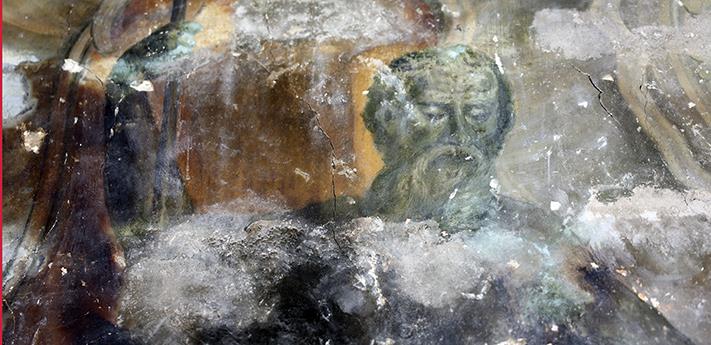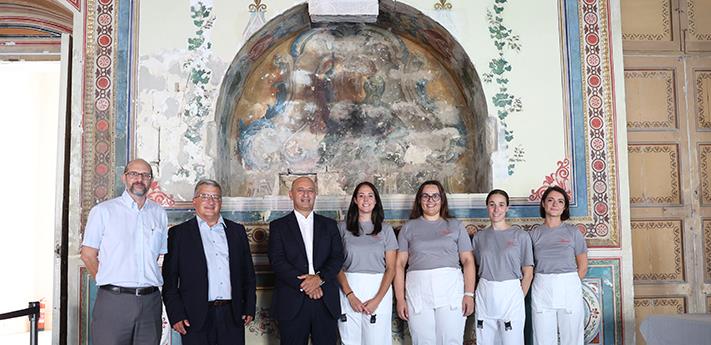A painting discovered behind a blocked arch at the Gran Salon within the National Museum of Archaeology in Valletta has been confirmed as an image of Neptune, the Roman God of the Sea, following a conservation project held by Heritage Malta with Bank of Valletta’s (BOV) support.
The painting, which sees the god hold a trident in his hand, was first discovered in 2021 during the project. It stands above what used to be a recessed arch with a fireplace that was blocked and redecorated.
As they were removing the pointing of the blocked-off access, conservators witnessed decorative elements completely different from the current decorative scheme of the Gran Salon, and a small opening was thus made, revealing details of a trident.

A close-up of the painting that was discovered, showing Neptune holding a trident / BOV
Following discussions of the findings with several professionals, the conservation team and Heritage Malta experts, with the approval of the Superintendence of Cultural Heritage, continued to meticulously remove stones blocking the archway to reveal a painting of Neptune that could possibly date to the late 17th or early 18th century.
Neptune is seated in the centre of a large seashell, resting his left hand on a jar with flowing war, while holding the trident in his right hand. He is depicted in a green colour, with the experts claiming it might have been done so he imitates bronze statues. As part of the decorative scheme there are also some architectural features among other shells and fish. They claim that to date, this is the only surviving element of the original decorative scheme of the Gran Salon, a majestic hall in the Auberge de Provence – now housing the National Museum of Archaeology – which was most probably fully decorated during the Knight’s period, yet was redecorated during the British Period.
The restoration of the hall commenced in 2017 through a partnership between BOV and Heritage Malta, with the bank’s participation in the project forming part of its commitment to “support and assist the community in which it operates”, going beyond the provision of financial services but as an “active citizen of this community”.
BOV CEO Kenneth Farrugia and Chief Operating Officer (COO) Ernest Agius recently visited the Gran Salon to witness the discovery, and they were greeted by Heritage Malta COO Kenneth Gambin and the conservation team, who provided an update on the conservation process.

From left: Heritage Malta COO Kenneth Gambin, BOV COO Ernest Agius and BOV CEO Kenneth Farrugia, together with conservators / BOV
“As a bank celebrating its 50th anniversary next year, and with over 200 years of history in Malta, the local heritage is very close to our hearts and forms an integral part of BOV’s Community Programme,” Mr Farrugia said.
“We are indeed very excited to form part of this exciting discovery together with Heritage Malta and we are keen to follow any new information that this discovery will shed on the history of this magnificent hall,” he added.
Mr Gambin expressed his delight at the discovery of this early decorative scheme, which “further enhances” the Gran Salon’s value and beauty. He lauded the efforts of Heritage Malta’s conservators who had a crucial role in the project, and also thanked BOV for its “unwavering support”.
He remarked that Heritage Malta is eager to make this discovery accessible to the public, in line with its commitment to “bring Malta’s cultural heritage within the reach of the widest audience possible”.
Main Image:The painting that was discovered, showing Neptune holding a trident / BOV
